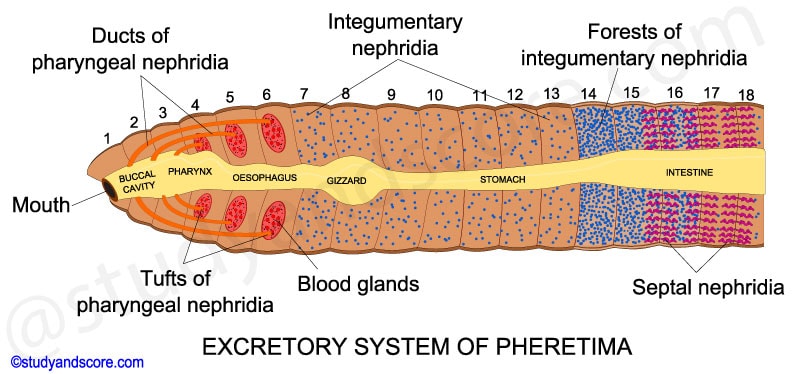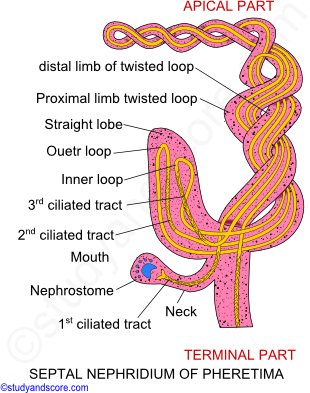The excretory organs of earthworm are minute, coiled tube like structures called nephridia. Nephridia are ectodermal in origin. They are derivatives of the ectodermal ciliated ducts, several types of nephridia occur in earthworm
Structure of typical nephridia: The typical nephridia are found in earthworms like Drawida grandis. It consists of three parts,
The body of nephridium is divided into ciliated, glandular and muscular regions. Ciliated and glandular regions are intracellular in origin; muscular region is intercellular in origin. The glandular region collects nitrogenous waste from the blood and the nephrostome collects waste from the coelomic fluid.
Nephridia with nephrostome are called open-nephridia and those with no nephrostome are called as closed-nephridia. The nephridia which open out through nephridiopore are called exonephric nephridia and those which open into the gut are called enteronephric nephridia.
The typical nephridia described above are absent in Pheretima posthuma. In Pheretima posthuma three types of nephridia are present namely septal nephridia, integumentary nephridia and pharyngeal nephridia. In Pheretima, nephridia occur in all the segments except the first two. Most of the excretory fluid is released into the alimentary canal from where it is sent out though anus along with the undigested food.

Septal nephridia: Septal nephridia are present on the intersegmental septum starting from 15th or 16th segment and continue till the last segment. They are present in four rows; two rows on each of the anterior and posterior faces of a septum. They are arranged in a row on each side of the alimentary canal on each face of the septum. Each row contains 20-25 nephridia. Except in 15th segment and in the anal region, all other segments contain 80-100 septal nephridia each.
Septal nephridium consists of funnel called nephrostome followed by neck and body of nephridium. The body of the nephridium consists of a short straight lobe, a long spirally twisted loop with a narrow apical part and terminal duct, which joins the septal excretory canal.

The funnel like nephrostome is a ciliated and round structure that opens into the coelom. So the septal nephridia are also called as open nephridia. A narrow long ciliated tubule called neck leads from the funnel into the body of the nephridium. Twisted loop of the long tubule consists of two limbs, a proximal limb and a distal limb, spirally twisted around each other. At the base of the nephridium, the straight lobe is connected with the distal limb of the twisted loop. The proximal limb on one hand receives the neck and on the other hand gives off the terminal duct.
Integumentary nephridia: Integumentary nephridia are smallest nephridia of Pheretima. So they are also called as micro nephridia. They lie scattered on the entire internal surface of the body wall except in the first two segments. They are V shaped structures and hang out in the coelom. The number ranges from 200-250 in each segment, except in the clitellar segments. In the clitellar segments they are ten times more than the usual number.
Such large numbers of integumentary nephridia in the clitellar region are referred to as forests of nephridia. Integumentary nephridia do not have coelomic funnel and are described as closed type. They open out independently through nephridiopores on the outer surface of the body wall and are described as exonephric nephridia.
Pharyngeal nephridia: Pharyngeal nephridia are located in 4th, 5th and 6th segments. They lie on either side of the pharynx and oesophagus and paired bunches. Hence they are also described as tufted nephridia. Each tuft consists of large number of nephridia. The terminal ducts of these nephridia join together and form a long thick walled duct, which opens into the gut.
The pair of ducts from the nephridial bunches of the sixth segment opens into the buccal cavity, while those from the nephridia of the fourth and fifth segments open into pharynx. These nephridia lack the nephrostome and hence they are closed type. Just like the septal nephridia, these nephridia discharge their excretory products into the lumen of the gut. So they are described as enteronephric nephridia.
Physiology of excretion: The chief nitrogenous waste products of Pheretima are ammonia, urea and creatinine. These nitrogenous waste products are found in the blood, coelomic fluid and excretory fluid of the earthworms. All the nephridia have a abundant supply of blood, they collect nitrogenous wastes from the blood. The septal nephridia communicate with the coelom through their nephrostomes and hence they can eliminate excretory wastes both from the blood and coelomic fluid. Eleocytes are collected by the sepal nephridia from the coelomic fluid.
Urine is hypotonic both to blood and the coelomic fluid. Nephridia play an important role in osmoregulation. The enteronephric nephridial system in Pheretima, which discharges excretory fluid into the lumen of the intestine, is an adaptation for conservation of water. Thus these nephridia help also in osmoregulation. Earthworms mostly excrete urea as the excretory products and are describes as ureotelic animals. Chloragogen cells also help in excretion.
There are no special respiratory organs in earthworm. Exchange of respiratory gases takes place through the thin moist body wall. In the body wall there is extensive system of blood capillaries. The respiratory pigment hemoglobin is dissolved in the plasma of the blood. Hemoglobin carries oxygen from the blood to the body wall of the tissues.
The epidermis is a permeable membrane through with carbon dioxide of the blood is exchanges for the oxygen of the atmosphere. Effective exchange of gases can take place only when the skin is moist, the body wall is kept moist by the dampness of the soil, the coelomic fluid which oozes out through the dorsal pores and the mucus secreted by the epidermal cells. If the body wall dries up, the earthworm dies due to the suffocation.

- Share with your friends! -
Login to post your comment here...
- or with social Account -